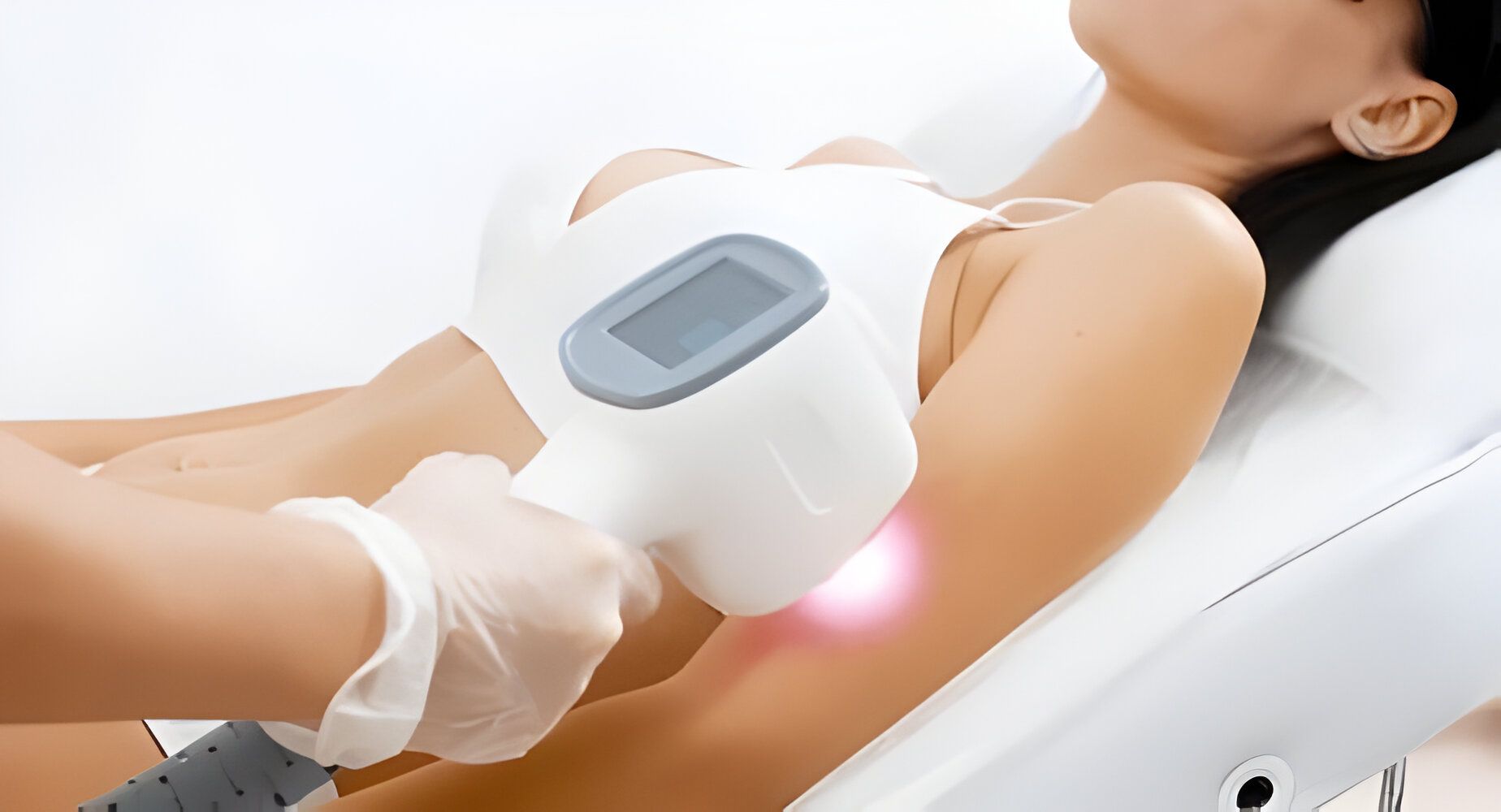Laser Hair Removal: Myths vs Facts
Laser hair removal is a popular procedure using concentrated light to destroy hair follicles for long-lasting results. Despite myths, it's not extremely painful, with discomfort often compared to a rubber band snap and modern lasers equipped with cooling mechanisms.
It's effective for various hair and skin types, though it significantly reduces hair growth rather than guaranteeing permanent removal, necessitating multiple sessions for optimal results. Importantly, there's no scientific evidence linking it to cancer, as lasers specifically target hair follicles without affecting the surrounding skin. Understanding these facts helps dispel myths and make informed decisions.
Understanding Laser Hair Removal
How Laser Hair Removal Works
Laser hair removal operates by directing concentrated beams of light at the pigmented roots of hair follicles. The pigment, known as melanin, absorbs this light, which then converts to heat and effectively destroys the hair follicle without damaging the surrounding skin. This process is known as photothermolysis. Treatments are spaced out, usually several weeks apart, to coincide with the growth cycle of hair, ensuring each session targets hair in its active growth phase.

Ideal Candidates
While laser hair removal can be effective for various skin and hair types, it works best on individuals with light skin and dark hair due to the contrast which allows the laser to better target the hair pigment. Advances in technology, however, have made the procedure safer and more effective for a broader range of skin tones and hair types. Consultation with a qualified professional can determine the best approach and laser type for your specific needs.
Preparation and Aftercare
Preparation for laser hair removal typically involves avoiding sun exposure and refraining from other hair removal methods like waxing or plucking that disturb the hair follicle. Post-treatment care includes moisturizing the treated area, avoiding sun exposure, and refraining from activities that cause excessive sweating. Adhering to these guidelines helps minimize side effects such as redness or irritation and promotes optimal results.
Potential Side Effects
Common side effects of laser hair removal include temporary discomfort, redness, and swelling at the treatment site. In rare cases, changes in skin pigmentation or blistering may occur, particularly in individuals with darker skin tones. Choosing a skilled and experienced practitioner significantly reduces the risk of adverse effects and ensures the treatment is tailored to your skin type and sensitivities.
Cost and Commitment
While the upfront cost of laser hair removal can seem high, its long-term benefits often justify the expense. The total cost depends on factors such as the size of the area being treated, the number of sessions required, and the geographical location of the service provider. It's essential to consider laser hair removal as an investment in long-lasting hair reduction rather than a one-time expense. Multiple sessions are typically needed for the best results, as the procedure targets hairs in different growth stages.
Myth Busting
One of the most prevalent myths about laser hair removal is that it guarantees permanent hair removal. In reality, while the treatment can significantly reduce hair growth, some maintenance sessions may be required over time. Another common misconception is the level of pain involved. Though there is some discomfort, modern laser technology and cooling systems have made the procedure much more tolerable.
Understanding the intricacies of laser hair removal—from how it works to what you can expect—can help you make an informed decision and set realistic expectations for the outcomes. Always consult with a certified professional to discuss your suitability for the procedure and any concerns you may have.
Myth: Laser Hair Removal is Extremely Painful
Understanding the Sensation
A common myth about laser hair removal is that it is extremely painful. In reality, the sensation experienced during the procedure is often described as comparable to the snap of a rubber band against the skin. While this might cause mild discomfort, it is far from intolerable. Pain perception can vary from person to person, influenced by individual pain thresholds and the sensitivity of the treatment area.
Technological Advances
Modern advancements in laser technology have significantly reduced the pain associated with laser hair removal. Many contemporary laser systems are equipped with built-in cooling mechanisms that help to alleviate discomfort by cooling the skin before, during, and after the laser pulse. Additionally, newer techniques such as motion-based laser treatment can gradually increase the energy applied, making the experience more comfortable than traditional static laser treatments.
Pain Management Strategies
For those who are more sensitive, several pain management strategies can be employed to further minimize discomfort. Topical numbing creams can be applied to the treatment area before the session to reduce the pain sensation. Some practitioners also offer cooling gels or air-cooling devices that can be used in conjunction with laser treatment to enhance comfort.

Areas of Higher Sensitivity
Certain areas of the body may be more sensitive to laser hair removal due to thinner skin or a higher concentration of nerve endings. Commonly sensitive areas include the upper lip, underarms, and bikini line. Discussing these concerns with your practitioner can help in tailoring the treatment to minimize discomfort, possibly by adjusting the laser settings or focusing on smaller sections at a time.
Comparing to Other Hair Removal Methods
When compared to other hair removal methods like waxing, laser hair removal may actually be less painful for many individuals. Waxing involves ripping hair out from the root, which can be quite painful and is performed repeatedly. In contrast, laser hair removal targets hair follicles with light, usually causing less trauma to the skin.
While it is natural to have concerns about pain, understanding the actual sensations involved, as well as the technological and procedural advancements, can provide reassurance. Consult with your practitioner about any worries you may have, and they can offer practical solutions to ensure a more comfortable experience. Ultimately, the temporary discomfort is often considered a small price to pay for the long-term benefits of hair reduction.
Effectiveness on Different Hair and Skin Types
Skin Types
The effectiveness of laser hair removal can vary based on skin type. Generally, individuals with lighter skin and darker hair tend to experience the best results. This is because the contrast between the pigment of the hair and the skin allows the laser to target the hair follicle more precisely. Advancements in laser technology have made it possible for people with darker skin tones to benefit from the treatment as well. Specialized lasers, such as the Nd:YAG laser, are designed to safely and effectively treat darker skin by minimizing the risk of skin damage and pigmentation changes.
Hair Thickness and Color
Hair thickness and color also play a significant role in the effectiveness of laser hair removal. Coarser and darker hair tends to absorb more laser energy, making the removal process more effective. Conversely, fine or light-colored hair, such as blonde, red, or gray, may not respond as well to the treatment. Some lasers, like the Alexandrite laser, are particularly effective for thicker hair, while diode lasers can offer better results for finer hair types.
Considerations for Different Areas
Different areas of the body can respond differently to laser hair removal based on the skin and hair characteristics unique to each region. For instance, the facial area, which often has finer hair, may require more sessions compared to areas with coarser hair like the legs or back. Similarly, hormonal influences can affect hair growth patterns in areas such as the face or chest, particularly in women, potentially necessitating additional maintenance treatments.
Customizing Treatment Plans
Due to these variances, a customized treatment plan is crucial for achieving the best results. During the initial consultation, the practitioner will assess your hair and skin type to determine the most appropriate laser technology and treatment settings. This tailored approach not only enhances the effectiveness of the treatment but also minimizes the risk of side effects.
Pre- and Post-Treatment Care
To maximize the effectiveness of laser hair removal, adhering to pre- and post-treatment care guidelines is essential. For all skin types, it is important to avoid sun exposure before and after each session, as tanned skin can increase the risk of side effects. Additionally, following post-treatment instructions such as moisturizing the treated area and avoiding heat-based activities can help promote better outcomes.
Understanding the effectiveness of laser hair removal across different hair and skin types allows for a more informed approach to the treatment. With the right laser technology and a personalized treatment plan, individuals with various hair and skin characteristics can achieve significant and long-lasting hair reduction.
Myth: Laser Hair Removal Guarantees Permanent Hair Removal
Understanding the Myth
One of the most common misconceptions about laser hair removal is that it guarantees permanent hair removal. It's essential to understand that while laser hair removal significantly reduces hair growth, it does not typically result in permanent hair removal.
Permanent Hair Reduction
Laser hair removal works by targeting and damaging the hair follicles, which can lead to a substantial reduction in hair growth. Most individuals experience a marked decrease in hair density, with the remaining hairs often becoming finer and lighter. Some hair follicles may survive the treatment, leading to the eventual regrowth of hair over time. Therefore, it is more accurate to describe the results as long-term hair reduction rather than permanent removal.
Maintenance Sessions
To maintain the desired level of hair reduction, periodic maintenance sessions are often necessary. The frequency of these sessions can vary depending on individual hair and skin characteristics, but it is not uncommon to require touch-ups every six months to a year after completing the initial treatment series. These maintenance sessions help in managing any new hair growth and ensuring that the results remain optimal.
Individual Responses
The effectiveness of laser hair removal can differ from person to person. Factors like hormonal changes, skin type, hair color, and hair growth cycle play a significant role in the overall outcome. For instance, hormonal fluctuations, particularly those related to pregnancy or conditions like polycystic ovarian syndrome (PCOS), can trigger new hair growth even after successful laser treatment, necessitating additional sessions.
Technological Advances
While no laser system can guarantee absolute permanence, advancements in technology have continually improved the efficacy of hair removal treatments. Higher precision lasers and customized treatment protocols have increased the ability to achieve long-term hair reduction for a broader range of skin and hair types. Maintaining realistic expectations is crucial for overall satisfaction with the results.
By understanding the limitations and capabilities of laser hair removal, individuals can make more informed decisions and achieve the best possible outcomes tailored to their unique hair and skin characteristics.
Number of Sessions Required
Initial Treatment Phase
The number of sessions required for effective laser hair removal can vary considerably based on several factors, including the targeted area, hair type, and individual skin characteristics. Typically, most individuals will need between 6 to 8 sessions during the initial treatment phase to achieve a significant reduction in hair growth. These sessions are usually spaced 4 to 6 weeks apart to align with the hair growth cycle, ensuring that the laser targets hairs in the anagen, or active growth, phase.
Factors Affecting Session Count
Multiple factors influence the total number of sessions needed to achieve optimal results. These include:
- Hair Color and Thickness: Darker, coarser hair absorbs more laser energy, making it easier to treat. Lighter, finer hair may require additional sessions.
- Skin Tone: Darker skin tones may need more sessions to minimize potential side effects like pigmentation changes.
- Treatment Area: Larger areas, such as the back or legs, might require more time and sessions compared to smaller areas like the upper lip or underarms.
Body Area Variability
Different body areas respond uniquely to laser hair removal. While areas with denser hair, such as the bikini line or underarms, may show quicker results, finer hair on the face or arms might require additional sessions for effective reduction. Hormonal areas, such as the face or chest, may also need more treatments due to fluctuating hormonal levels that can affect hair growth.
Maintenance Sessions
Even after completing the initial series of treatments, maintenance sessions are crucial for long-term results. Typically, these touch-ups are required every 6 to 12 months to manage any new hair growth and to maintain hair-free results. The frequency of maintenance sessions can vary depending on individual hair regrowth rates and hormonal factors.

Personalized Treatment Plans
A personalized treatment plan crafted by a qualified practitioner will take into account all these variables to determine the optimal number of sessions for each individual. During the consultation, the practitioner will evaluate your skin and hair type, discuss any underlying conditions that might affect hair growth, and recommend a tailored treatment schedule to achieve the best results. By following this customized approach, individuals can maximize the effectiveness of laser hair removal while minimizing the risk of side effects.
Understanding the number of sessions required and the factors that influence them helps in setting realistic expectations and planning a course of treatment that is both effective and suited to your unique needs.
Contact Bel Viso Medical Spa
If you're ready to begin your journey toward long-term hair reduction, Bel Viso Medical Spa is here to help. Our experienced and qualified practitioners use the latest technology to provide safe, effective treatments tailored to your unique needs. Don't hesitate to reach out and schedule a consultation to discuss your personalized treatment plan. Take the first step towards smoother, hair-free skin today!
Our Recent News & Articles


We are here to enhance your natural beauty. When you walk into our medical spa, the focus is on you. We promote a collaborative treatment plan between the provider and client to achieve a realistic aesthetic outcome.
All Rights Reserved | Bel Viso Medical Spa
WEB SERVICES BY: LEVELUP DIGITAL SOLUTIONS



